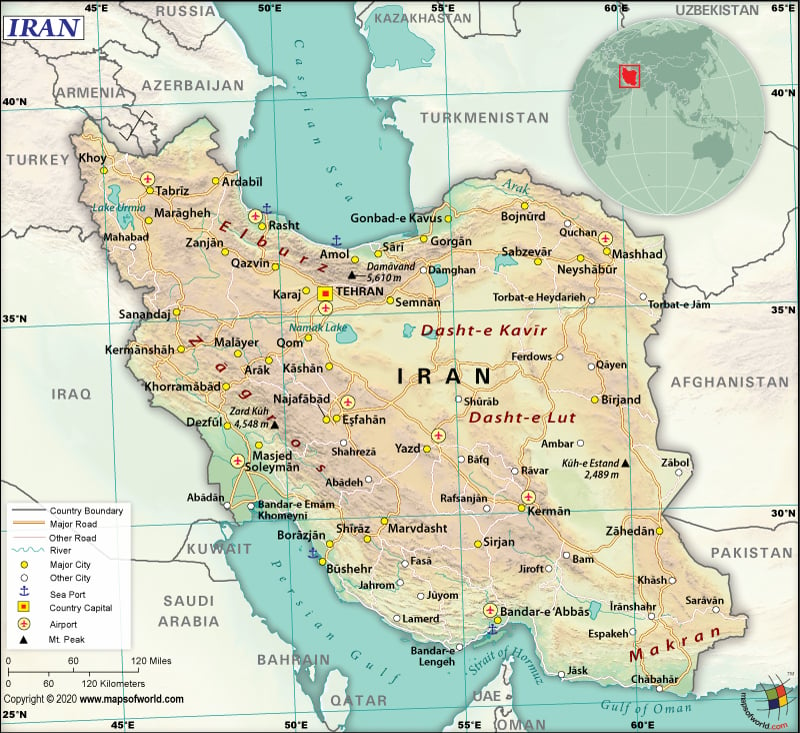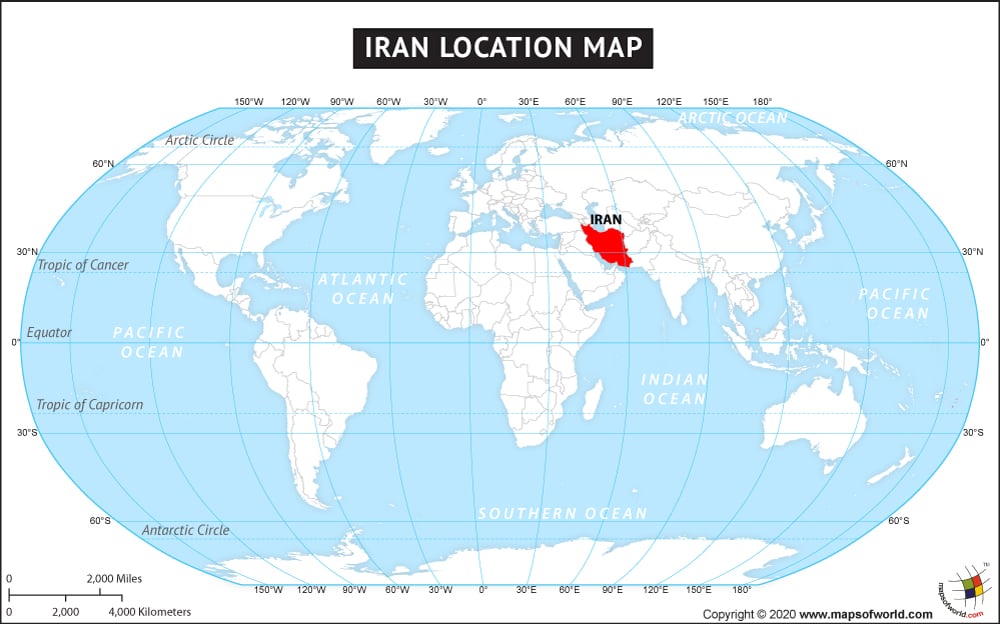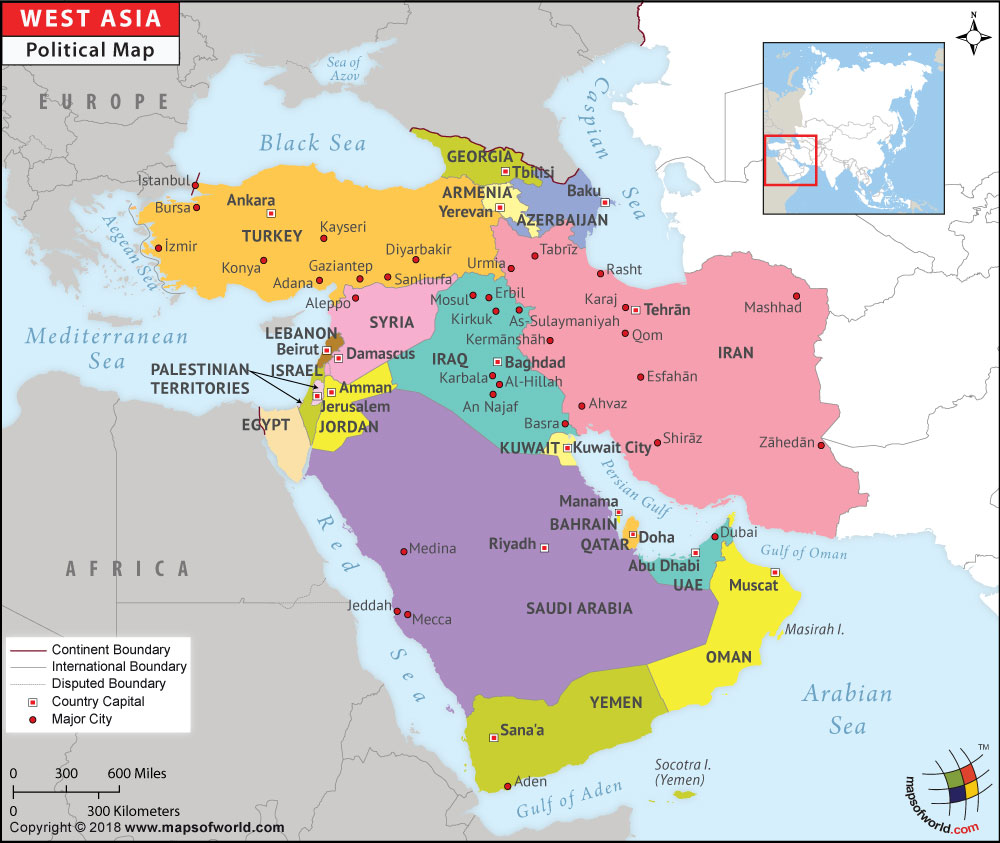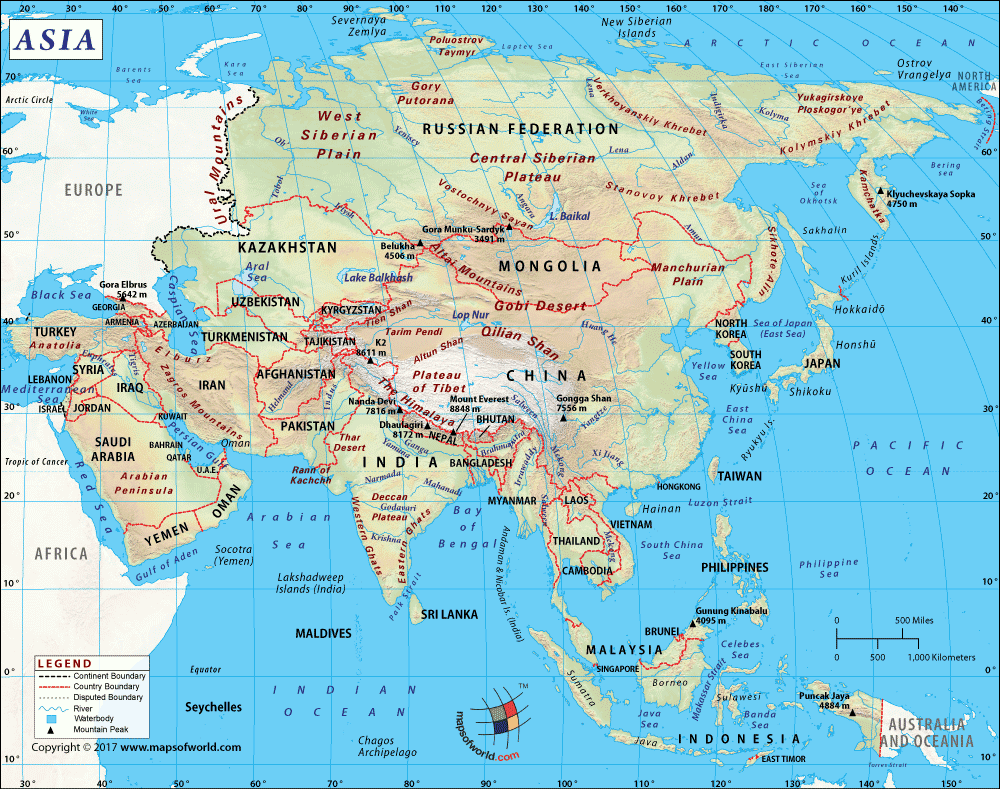What are the Key Facts of Iran?

|
Official Name |
Islamic Republic of Iran |
|
Continent |
Asia |
|
Capital |
Tehran |
|
Largest City |
Tehran |
|
Coordinates |
32.000000, 53.000000 |
|
Area |
636,372 sq. mi (1,648,195 sq. km) |
|
Land Boundaries |
3,662 mi (5,894 km) |
|
Coastline |
1,516 mi (2,440 km) |
|
Currency |
Rial (ریال) (IRR) |
|
Neighboring Countries |
Turkmenistan, Afghanistan, Pakistan, Azerbaijan, Armenia, Turkey, Iraq. |
|
Population |
81,800,270 (World Bank, 2018) |
|
Official Languages |
Persian |
|
Major Religion |
Islam |
|
National Day |
1 April (Republic Day) |
|
National Anthem |
“Soroud-e Melli-ye Jomhouri-ye Eslami-ye Iran” |
|
Form of Government |
theocratic republic |
|
Supreme Leader |
Ali Khamenei |
|
President |
Hassan Rouhani |
|
GDP per capita (PPP) |
$ 21,011.3 (World Bank, 2017) |
|
GDP per capita (nominal) |
$ 5,627.7 (World Bank, 2017) |
|
HDI |
0.797 (2018), Rank: 65 |
|
Literacy Rate (%) |
85.54 (UNESCO, 2016) |
|
Space Agency |
Iranian Space Agency |
|
Military Expenditure Ranking |
18 (SIPRI, 2018) |
|
No. of Olympic Medals |
1 (as of 2018) |
|
Driving Side |
right |
|
Calling Code |
98 |
|
Time Zone |
UTC+3:30 (IRST), Summer (DST): UTC+4:30 (IRDT) |
|
Internet TLD |
.ir |
Where is Iran?
Iran (officially called the Islamic Republic of Iran) is a country, located in Western Asia. Its location has geostrategic importance. The Islamic Republic of Iran is located in the central part of Eurasia and Western Asia.
What is the Geography of Iran?
Iran is spread across a total area of 1,648,195 sq. km (636,372 sq. mi), making it the 2nd largest country in the Middle East. Out of the total area, 1,531,595 sq. km (591,352 sq. mi) is land area and 116,600 sq. km (45,018 sq. mi) is water area.
It shares 1,599 km (993.57 mi) of its border with Iraq (to the west), 534 km (331.81 mi) with Turkey (to the west), 959 km (595.9 mi) with Pakistan (to the east), 921 km (572.3 mi) with Afghanistan (to the east), 1,148 km (713.3 mi) with Turkmenistan (to the northeast), 689 km (428.1 mi) with the Republic of Azerbaijan (to the northwest), and 44 km (27.3 mi) with Armenia (to the northwest).
Iran also borders the Caspian Sea (to the north), the Gulf of Oman (to the south), and the Persian Gulf (to the south). The total coastline of the country is 2,440 km (1,516 mi). It also has a 740 km (460 mi) long shoreline on the Caspian Sea.
The terrains of Iran include the rugged and mountainous rim, discontinuous small plains along the coasts, and a high, central basin having deserts and mountains. The mean elevation of Iran is 1,305 m (4,281.5 ft). While Kuh-e Damavand at 5,625 m (18,454.7 ft) is the highest elevation point, the Caspian Sea at -28 m (-91.9 ft) is the lowest elevation point.
The landscape of the country is dominated in the north by the Elburz Mountains and by the Zagros Mountains along the western borders. The Plateau of Iran is located in the central part of the country. One of the hottest places on earth during summer is the Dasht-e Kavir, which is a sandstone and salty desert plateau. Some of the major mountains in Iran are Damavand, Alam-Kuh, Sabalan, Zard-Kuh, Kuh-e Hazar, Dena, Kuh-e Palvar, Kuh-e Jupar, Shir Kuh, and Taftan.
The names of the longest rivers in the country are Aras, Karun, Karkheh, Sefid-Rud, Atrek, Diyala, Lower Zab, Dez (Coprates), and Zayanderud. Some of the major lakes are Lake Urmia, Namak Lake, Maharloo Lake, Neor Lake, Gahar Lakes, Ovan Lake, Lake Zerivar, Valasht Lake, and many more. While Lake Urmia (located in the far northwest of Iran) is the largest water body of Iran, the Karun River is the most significant of all the rivers flowing through the country.
What is the Climate of Iran?
A hot and dry climate persists in Iran. The climatic condition is characterized by short and cold winters as well as long, hot, and dry summers. Two conditions influence Iran’s climate: the Arabian Desert area’s subtropical aridity as well as the eastern Mediterranean area’s subtropical humidity.
While January is the coldest month in Iran with the temperature ranging within 5-10 °C (41-50 °F), August is the hottest month with the temperature reaching within 20-30 °C (68-86 °F) or sometimes even more.
During summer, most of the areas have a warm-to-hot climate with the characteristic feature of continuous sunshine. In the southern coastal regions of the Persian Gulf, the humidity remains high. The daily temperature can become very hot, and it can easily reach 40°C or more on some days. The regions located along the Persian Gulf as well as the Oman Sea experience the danger of heat exhaustion.
Most of the rainfall (around 70 percent) takes place from November-to-March. About five months of the year (from June to August) often remain rainless.
What is the Economy of Iran?
Iran has a diversified economy, which is characterized by a central planning-based economic system, state ownership of oil and other major enterprises, small-scale private trading and services, and village agriculture. Medium-scale economic activities include mining, construction, metalworking, and cement production.
The annual Gross domestic product (GDP) of Iran witnessed significant growth during 2000-2012. The annual GDP of Iran was US$128,627 billion in 2002. It increased to US$598.853 billion in 2012. However, it then came down to US$385.874 billion in 2015. The GDP then increased to US$454.013 billion in 2017 (the growth rate was 3.76%).
The economy of Iran was the 46th largest export economy in the world in 2017. The total value of export and import were US$53.7 billion and US$49.9 billion, respectively, which resulted in a positive trade balance of US$3.84 billion.
The major export items are Crude Petroleum, Ethylene Polymers, Acyclic Alcohols, Refined Petroleum, and Iron Ore. The major import items of Iran are Cars, Vehicle Parts, Corn, Rice, and Broadcasting Equipment.
The rate of unemployment was high during April-June 2018, hovering around 12.1%. The gender gap in the labor market continues. That’s why the rates of unemployment among men and women were 10.2% and 19.7% respectively. However, the real pain point of the economy is the extremely high unemployment rate among youths, which was 28.3% in June 2018.
The labor force participation rate was 41.1% during the June quarter of 2018, the highest level in the last decade. Despite the persistence of the gender gap, Iran is among the top few countries where the female labor force participation rate has been the highest. In 2017-18, it was 19.8%.
The Research Center of the Iranian parliament’s new study finds that the rise in the cost of living in Iran’s urban and rural areas has increased the poverty rate in Iran. During 2017-18, the cost of meeting the basic needs in Iran’s urban and rural areas increased by 22-26% and 25-30% respectively. The poverty rate in urban and rural areas was 14.9% and 11.6% respectively.
The provinces having the highest poverty rates were Sistan and Baluchestan (38%), Kerman (33%), and Qom (30%). However, the poverty rate was just 12% in Tehran.
What is the Transportation System of Iran?
Iran has an elaborate transportation system. There are 319 airports, out of which 140 have paved, and 179 have unpaved runways. Twenty-six heliports are also there. Over 223,485 km (138,867.1 mi) of roadways are functional in Iran, out of which 195,485 km (121,468.7 mi) is paved and 28,000 km (17,398.4 mi) is unpaved. The waterway system is 850 km (528.2 mi) long, mainly present on the Karun River and Lake Urmia. Some of the major seaports in Iran are Bandar-e Asaluyeh, Bandar Emam, and Bandar Abbas. The country has over 720 merchant marine vessels.
What International Organizations is Iran part of?
UN, UNESCO, IMF, ILO, WHO, CICA, CP, D-8, ECO, FAO, G-15, G-24, G-77, IAEA, IBRD, ICAO, ICRM, IDA, IDB, IFAD, IFC, IFRCS, IHO, IMO, IMSO, Interpol, IOC, IOM, IPU, ISO, ITSO, ITU, MIGA, NAM, OIC, OPCW, OPEC, PCA, UNAMID, UNCTAD, UNHCR, UNIDO, UNITAR, UNWTO, UPU, WCO, WIPO, WMO, WTO (observer), ICC (national committees), SAARC (observer), SCO (observer), WFTU (NGOs)
Related Links:
- Can Iran be Threat to the USA?
- What is Iran: Sunni or Shia?
- Which Continent does Persia belong to?
- What is the history of the Shia-Sunny split?


